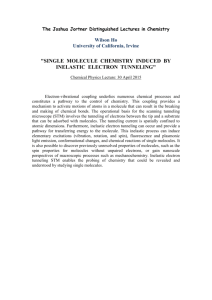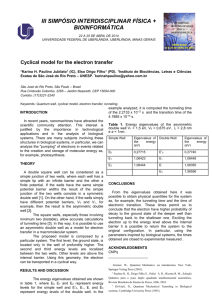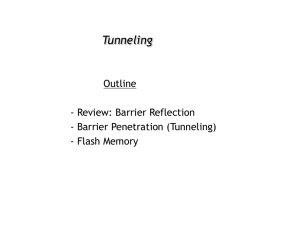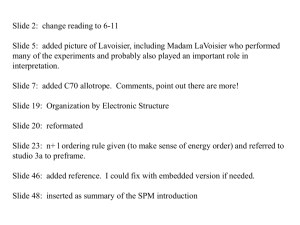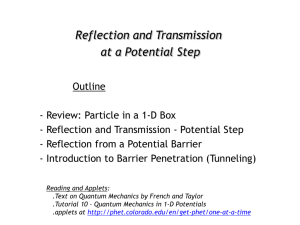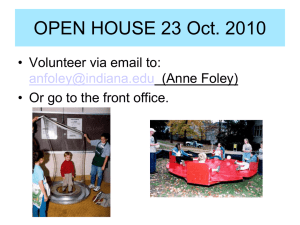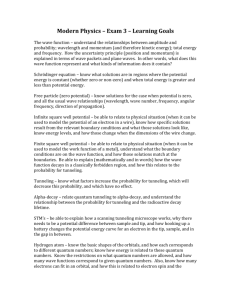α Bonds and Wavefunctions Module Scanning Tunneling Microscopy
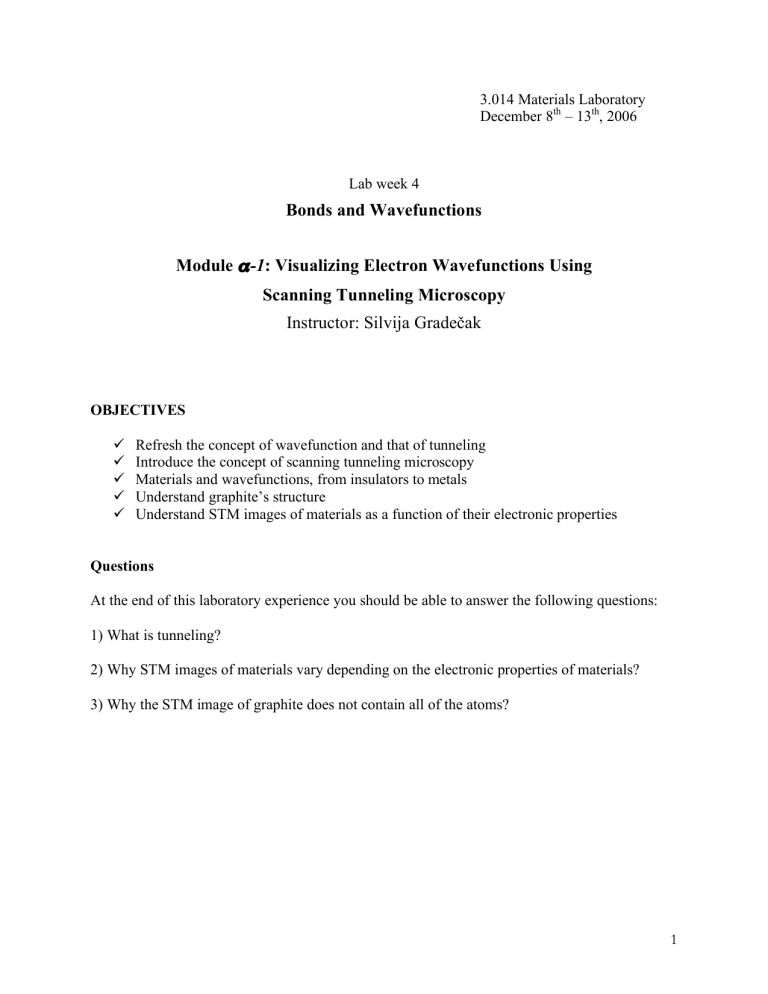
3.014 Materials Laboratory
December 8 th – 13 th , 2006
Lab week 4
Bonds and Wavefunctions
Module
α
-1
: Visualizing Electron Wavefunctions Using
Scanning Tunneling Microscopy
Instructor: Silvija Grade
č
ak
OBJECTIVES
Refresh the concept of wavefunction and that of tunneling
Introduce the concept of scanning tunneling microscopy
Materials and wavefunctions, from insulators to metals
Understand graphite’s structure
Understand STM images of materials as a function of their electronic properties
Questions
At the end of this laboratory experience you should be able to answer the following questions:
1) What is tunneling?
2) Why STM images of materials vary depending on the electronic properties of materials?
3) Why the STM image of graphite does not contain all of the atoms?
1
INTRODUCTION
This module is designed to help solidify the concept of wavefunction and to link it to materials properties. The goal is to demonstrate the fundamental role of wavefunctions in determining materials properties. To do so, we will image (or attempt to image) the wavefunction on the surface of three different classes of materials:
•
Gold, a metal (conductor)
• Graphite, a zero band gap semiconductor
• An octyl-thiol -- CH
3
-(CH
2
)
7
-SH -- self-assembled monolayer (insulator)
We will show that the relationship between the image of a surface obtained by a scanning tunneling microscope (STM) and the real atomic structure of the same surface varies depending on the nature of the electron wavefunction in the material.
An STM image represents the convolution of the wavefunction of the microscope tip with the wavefunction of the material being imaged. We can assume that the wavefunction of the tip is always the same; thus, we will attribute the difference between various images to difference in the wavefunctions of the materials at the surface.
BACKGROUND
Tunneling
Tunneling is one of the most interesting phenomena to arise from quantum mechanics. It is a direct consequence of the wave nature of particles and has no classical mechanics counterparts.
In quantum mechanics tunneling describes ability of a particle to penetrate classically-forbidden regions of space and can be explained only by the wave-like nature of particles.
Let us consider a particle with total energy E and a potential barrier of height V , where V > E . In the classical mechanics, the particle does not have enough energy to surmount this barrier. In quantum mechanics, however, there is a finite probability of finding the particle in or past the barrier. This is a direct consequence of the definition of wavefunction and the requirement that a wavefunction and its first derivative must be everywhere continuous (wavefunction does not end abruptly at a wall of the barrier, but taper off quite quickly-exponentially). If the barrier is thin enough, the probability function may extend into the next region, though the barrier. Because of the small probability of particles being on the other side of the barrier, some will indeed move through and appear on the other side. When a particle moves though the barrier in this fashion, it is called tunneling.
Although tunneling can look like an abstract concept with no realistic consequences, it has been used to generate one of the most amazing instruments in modern physics, the scanning tunneling microscope. To understand the basic working principle of STM, let us consider metal-vacuummetal tunneling.
2
The work function φ of a metal surface is defined as the minimum energy required to remove an electron from the bulk to the vacuum level. Neglecting the thermal excitation, Fermi level is the upper limit of the occupied states in a metal. Taking the Fermi level as a reference point (zero potential), Schrödinger equation of an electron at the metal-vacuum interface can be written as following:
#
%
$
" h 2
2m d 2 dx
2
+ V (x)
&
(
)
'
(x) = E ) (x)
V (x) =
+ 0, x < 0
,
* , x > 0
!
V(x)
φ
x
Figure 1 : Step-like potential at the metal-vacuum interface.
Solution to this Schrödinger equation in the step-like potential is the electron wavefunction is given in Figure 2.
ψ (x) x
Figure 2 . Wavefunction of an electron at the step-like potential (source: MIT OCW).
3
There is a number of web-based applets that can be used to solve Schrödinger equation in arbitrary potentials (for example, in the 3.012 class, you were asked to try out Java applet under http://www.its.caltech.edu/~amosa/website/boundstates.html
). To visualize electron wavefunction in step-like potential, we will use the aplet at the following internet address: http://www.quantum-physics.polytechnique.fr/en/index.html
By changing the electron energy, you can visualize its wavefunction (Figure 3). Why don’t you try out the applet yourself?
Courtesy of Manuel Joffre. Used with permission.
Figure 3 . Wavefunction of an electron at the step-like potential (http://www.quantumphysics.polytechnique.fr/en/index.html)
4
If we now imagine two metal surfaces in close vicinity, electrons will feel potential barrier, rather than a step-like potential. Depending on the thickness of the barrier, they will have a certain probability of tunneling through the barrier (Figure 4).
Figure removed due to copyright restrictions.
Courtesy of Manuel Joffre. Used with permission.
Figure 4 . Tunneling of an electron through a potential barrier and effect of the barrier thickness
(http://www.quantum-physics.polytechnique.fr/en/index.html)
5
Scanning Tunneling Microscopy
In STM, electrons tunnel from a metallic tip (typically made of either a Pt/Ir alloy or of W) into a conductive sample through an insulating gap (air, liquid, or vacuum). To relate to our schematics above, the insulating gap is the barrier through which the electrons must tunnel to get from tip to sample.
The microscope measures the current that flows between the tip and the sample as the tip scans along the surface (Figure 5), and
1. displays current vs. lateral tip position (constant height mode imaging), or
2. moves the tip up and down to adjust the current to a given current setpoint, and then displays an image of lateral tip position vs. vertical tip height (constant current mode)
Figure by MIT OCW.
Figure 5 . Working principle of STM.
To simplify discussion, we assume that the work functions of the tip and the sample are equal.
The electron in the sample can tunnel into the tip and vice versa. However, vithout a bias voltage, there is no net tunneling current. By applying a bias voltage V , a net tunneling occurs. A sample electron state with the energy level lying between E
F
eV and E
F
(Figure 6) has a chance to tunnel into the tip. We assume that the bias is much smaller than the value of work function and the energy levels of all the sample states of interest are close to the Fermi level. The probability of an electron to tunnel from the sample to the tip then depends on the sample density of states and tip to sample distance (Figure 6).
6
E f
- eV
Sample s
Tip
φ
E f
I/V
∝ ρ
e -2Ks
K =
( (
2
φ
1/2
ρ
= density of states
.
-1
Figure by MIT OCW.
Figure 6 . One-dimensional metal-vacuum-metal tunneling junction and tunneling probability
I/V. Value K was calculated for a W tip with the work function of 4.8eV.
The current measured is proportional to the overlap between the wavefunction of the electrons at the Fermi level of the tip and that of the electrons in the sample. Since the wavefunction of the tip is constant, we can interpret our STM image as a map of the wavefunction of the electrons on the surface of the sample.
In this laboratory we will image the surface of three different materials.
1. Metal
One material is Au (111), a metal. The crystal structure (e.g. atomic positions) of Au is shown in
Figure 7. How do you expect the STM image of this surface to look? Recall that electrons in metals are delocalized rather than being associated with one particular atom.
Figure 7 . Arrangement of atoms at the Au(111) surface (source: MIT OCW).
7
2. Zero-gap semiconductor
The second is graphite, whose structure is described in Figure 8.
Courtesy of National Academy of Sciences, U.S.A. Used with permission.
Source: Hembacher, S., F. J. Giessibl, J. Mannhart, and C. F. Quate. "Revealing the Hidden Atom in Graphite by
Low-Temperature Atomic Force Microscopy." PNAS 100 (2003): 12539–12542. Copyright 2003, National Academy of Sciences, U.S.A.
Figure 8 . Crystal structure of graphite (figure from reference 4). Courtesy of National Academy of Sciences, U. S. A. Used with permission. Copyright 2003, National Academy of Sciences, U.S.A.
3. Insulator
Finally, the third is an octyl-thiol self-assembled monolayer (SAM), bonded to the surface in a hexagonally packed arrangement (Figure 9). The SAM behaves as a thin insulating layer. How do you expect this image to look?
Figure by MIT OCW.
Figure 9 . Schematic representation of alkyl-thiol molecules on a gold surface (from reference 5).
8
Fourier Transforms
Fourier transforms are an important mathematical tool for the analysis of periodic phenomena.
Any function can be represented by a superposition of sine and cosine waves of different amplitudes and frequencies:
# f ( x ) = [ A ( " )cos " x + B ( " )sin " x
0
$ ] d "
By performing a Fourier transform on a function, we can represent it as a sum of sinusoidal amplitude will be large) and the amplitude at all other frequencies will be small.
Consider that our STM images are essentially functions on which we can perform a Fourier transform. What can this operation tell us about the surfaces we will study?
REFERENCES
1.
Scanning Tunneling Microscopy -From Birth To Adolescence , Nobel Lecture, Gerd
Binnig And Heinrich Rohrer, Ibm Research Division, Zurich Research Laboratory,
Switzerland, December 8, 1986
2.
Introduction to Scanning Tunneling Microscopy , C. Julian Chen, Oxford University
Press, 1993
3.
Scanning Probe Microscopes , Application in Science and Technology, K. S. Birdi, CRC
Press, Boca Raton, 1994
4.
Revealing the hidden atom in graphite by low-temperature atomic force microscopy ,
Stefan Hembacher, Franz J. Giessibl, Jochen Mannhart, and Calvin F. Quate, Proceeding of the National Academy of Science, 100, 12539–12542, 2003
5.
Characterization of Organic Thin Films , Abraham Ulman (Ed.), Butteworth-Heinemann,
Boston, 1989
6.
http://www.nanoscience.com/education/STM.html
9
